AMD Announces New, Higher Clocked Radeon HD 7950 with Boost
by Ryan Smith on August 14, 2012 11:00 AM ESTPerformance, Power, Temperature, & Noise
Because the 7950B is not strictly a new SKU, and because the performance of the 7950B isn’t very far ahead of the 7950, we’re going to keep our look at the 7950B’s performance relatively short. As always, if you want a complete breakdown of performance please see Bench, which has our complete results for the 7950B and over two dozen other cards.
Kicking things off, we wanted to start with a quick look at clockspeeds. Unfortunately AMD still hasn’t come through on their promise to expose the precise clockspeeds of their Southern Islands cards, which means we’re stuck looking at clockspeeds in a halfway blind manner. We cannot tell when PowerTune throttling has kicked in to push clockspeeds below 850MHz, and at the other end of the spectrum we cannot tell what PT Boost is doing when it’s boosting. As a result we can only see two card states, the base state of 850MHz when the 7950B is operating at or below 850MHz, and the PT Boost state of 925MHz when the 7950B is operating at between 851MHz and 925MHz. Still, this is just enough information to piece something together.
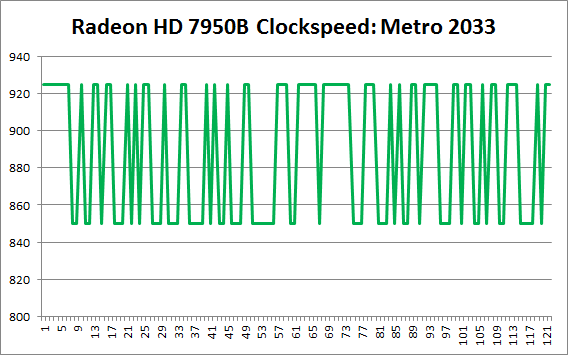
The above is a graph of clockspeeds when running Metro 2033 at 1920x1200, and it’s virtually identical to what we see with other games. The 7950B fluctuates wildly between its base state and its boost state. This is not the kind of behavior we see from the 7970GE or for that matter NVIDIA’s GTX 600 cards. This fluctuating behavior is unique to the 7950B.
So what’s going on? As near as we can tell, the power requirements for boosting are so high that the 7950B simply cannot maintain that boost for any significant period of time. Almost as soon as the 7950B boosts needs to go back to its base state in order to keep power consumption in check. The culprit here appears to be the 7950B’s very high boost voltage of 1.25v, which at 0.125v over the card’s base voltage makes the boost state very expensive from a power standpoint. If our theory is correct then this means that the 7950B never gets very far past its base clockspeed, and compared to the 7970GE, PT Boost is almost entirely wasted here.
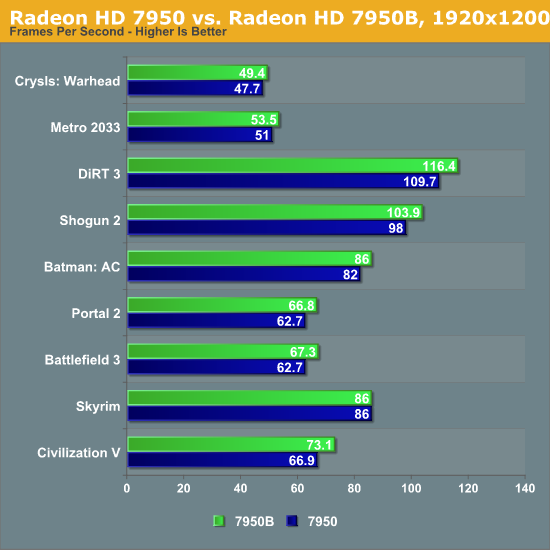
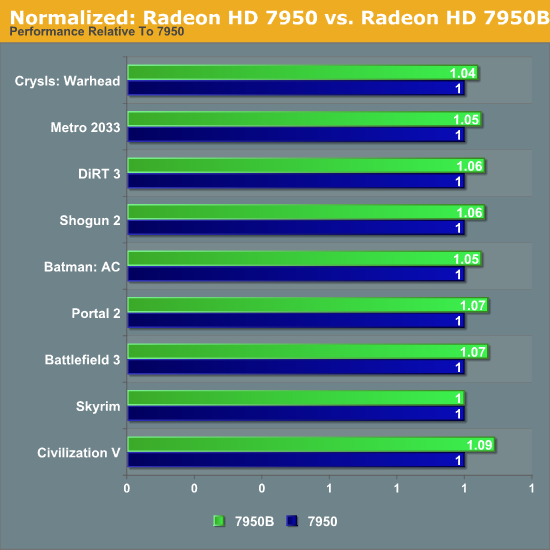
Looking at our performance charts, what we’re seeing would seem to confirm our theory. Keeping in mind that the base clockspeed of the 7950B is 6.25% higher than the 7950, the only time we see a significant jump in performance beyond that is with Civilization 5, where performance increases by 9%. Otherwise performance increases by merely 4% in Crysis, up to 7% in Battlefield 3. Not counting Skyrim (which is CPU limited), we’re looking at an average performance gain of just over 6%, which is very close to the increase in the base clockspeed relative to the 7950.
As we’ve stated before this is free performance and we’re happy to take it, but at the end of the day 6% is not nearly enough to matter with the current competition. Until such a time where the competitive landscape changes, the 7950 will continue to be well behind its next-closest competitor, GTX 670.
Power, Temperature, & Noise
Bringing things to a close, we quickly wanted to break out power, temperature, and noise. As we’ve stated earlier, AMD is making a clear set of tradeoffs with the 7970GE and 7950B, forgoing power efficiency in the name of performance. We’ve seen the 6% performance boost the 7950B offers, but what exactly has the cost been?
| Radeon HD 7950 Series Voltages | ||||
| Ref 7970B Base Voltage | Ref 7950B Boost Voltage | Ref 7950 Base Voltage | ||
| 1.125v | 1.25v | 1.093v | ||

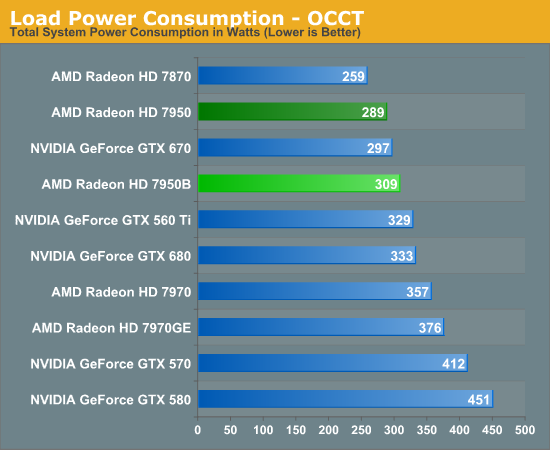
Starting as always with load power, we see that relative to the 7950, the 7950B’s power consumption at the wall is 20W higher in both tests. This fits well with AMD’s official specs, which have the TDP of the 7950B at 225W, versus 200W for the 7950. As a result of this power increase the 7950B draws more power than even the GTX 680 when it comes to Metro, though thanks to AMD’s more rigorous throttling their power consumption still comes in below the GTX 680 under OCCT.
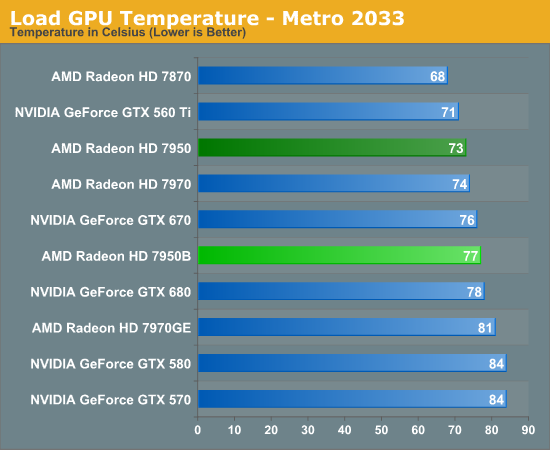
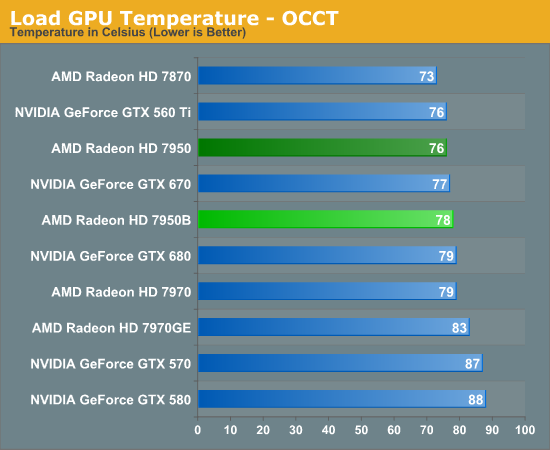
Moving on to load temperatures, it comes as no great surprise that with an increase in power consumption comes an increase in load temperatures. The 7950B still fares well here, staying below 80C in both tests, but the 4C jump in Metro is a bit more than we would have expected for only a 20W increase in power consumption.
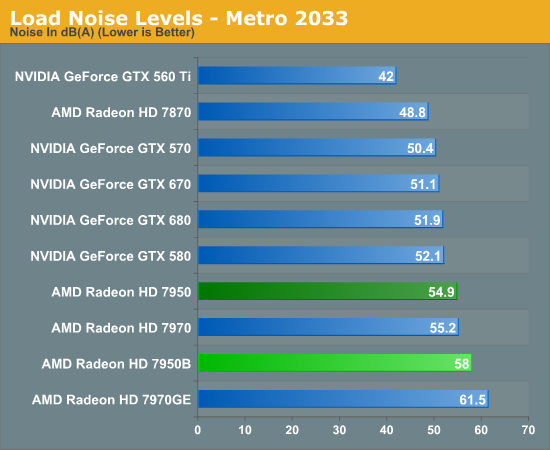

Last but not least we have our look at noise under load. Unfortunately the 7950B looks especially bad here, thanks to the more aggressive fan curve we typically see on 7950 cards. With both Metro and OCCT the 7950B is pushing 58dbA+, which is louder than even the better performing 7970. In fact all things considered this is quite a ridiculous amount of noise, the same problem the 7970GE had.
The good news is that the reference 7950 is rarely sold these days, but we have every reason to believe that aftermarket cards will see a similar jump in noise. There’s no getting around the fact that 225W is a lot of heat to dissipate, especially for designs that weren’t necessarily optimized around that level.
Wrapping things up, it’s difficult to hold a favorable opinion of the 7950B given what we’ve seen so far. AMD may be putting all of their focus into performance-per-dollar, but that doesn’t mean that performance-per-watt has suddenly stopped mattering. The 7950B’s performance boost is free from a price perspective, but the tradeoff that comes with it is anything but. A 6% jump performance for a 10% increase in power consumption and notable rise in load noise will certainly be acceptable to some users, but it’s difficult to argue that this is a good tradeoff overall.










58 Comments
View All Comments
Ryan Smith - Saturday, August 18, 2012 - link
"The problem is reviewers can't do anything which will piss off Nvidia. So they play by the 800 lb gorilla's rules. No reviewer has the guts to take a factory overclocked HD 7950, HD 7970, GTX 670, GTX 680 and push it to their maximum speeds with voltage tweaking."Honestly, I resent that remark.
What you propose is fundamentally unsound science. OVERCLOCKING IS NOT GUARANTEED. This especially goes for video cards as there's a wide variation in quality among GPUs.
When reviewing a card we will gladly overclock it just to give you an idea of what we achieve. But outside of roundups where we're looking at several similar cards, we will never, ever directly compare an overclocked card to another overclocked card. To do so and then to draw conclusions from that would be irresponsible if not negligent. We would be one bad (or particularly good) card away from drawing the wrong conclusion.
This brings us to testing methodologies and what is sound scientific testing. Overclocking is a wonderful bonus, but it is never something you should count on because a significant overclock cannot be guaranteed. The only thing that we can be certain of and thus the thing we should be testing on a typical card is its stock performance.
This also extends to “virtual” SKUs where manufacturers are shipping factory overclocked cards; we must test and base our opinions around reference-clocked cards, since they represent the bare minimum of performance for an entire family.
CeriseCogburn - Wednesday, August 29, 2012 - link
Looks to me like clock for clock the 7950 is 8% slower, not 3-5.The xfx has oc ram
33fps to 36 fps is about 8%, not 3 percent.
tcool93 - Wednesday, August 15, 2012 - link
Just so the non AMD video card owners know. This article is being biased about the noise. Due to the fact that they are using an AMD card that uses the hamster style wheel fan which is noisey. Most, if not all the 7950 cards use the single or better dual fan design which is MUCH quieter. Just check newegg if you don't believe me. They also run much cooler.But of course, that can't be reported because it might make AMD look good.
raghu78 - Saturday, August 18, 2012 - link
yeah you said it right. When they are so many custom cooler designs who is going to buy a ref cooler design which is louder. Actually I blame AMD. They should have sent a factory overclocked custom HD 7950 like Sapphire HD 7950 950 Mhz edition to reviewers and just told them to review it like the EVGA GTX 460 FTW edition.CeriseCogburn - Wednesday, August 29, 2012 - link
I will, I am an amd penny pinching freak fanboy, so I will buy the supercheap extra discounted, egg only, powercolor crapster or the visiontek tinker... of course, because I'm getting my amd bang for the buck... even after the massive driving into the dirt 3 times nVidia did to amd, I'm not satisfied - I might wait for the real 680 nVidia delayed to get rich off amd's fail, to get a really cheap amd card, hopefully another billion in debt for amd that means cheapo cards for me and my fanboy bruhs.seasick - Thursday, August 16, 2012 - link
that's a good move for amdand yeah why are people compairing gtx660ti with hd7950
its the same situation as we've seen last year
my hd7950 is a beast I just flashed the new bios and difference is just 3-5fps bt I oc that beast to sweet 1270mhz(with Arctic tt2) it even beats a gtx670 and touches the gtx7970ge
and it costed me 319$
and I agree that new hd7950 deserves a new name as well like 7955 or BoostEdition,which will give a clue to customers, what they are really buying ...(CON)
CeriseCogburn - Wednesday, August 29, 2012 - link
Plus $55 for the twin turbo actic, and another two or three hours to install, and probably thermal glue for the passive ram chip attachment.So $400 bucks at least, unless your time is worth nothing.
MrSpadge - Thursday, August 16, 2012 - link
1.25 V for 920 Mhz boost is totally ridiculous. My HD6950 is almost reaching this clock speed at 1.10 V - and that's on a 40 nm process. Granted you couldn't sell a card at such a tight clock speed tolerance, but AMD is not doing the majority of cards & users a favor here by aiming at the absolute worst chips. I hope manufacturers are using better binning & voltage settings. Absurd as it may seem, but a lower voltage would actually make the card faster (since it could turbo longer / more often).MrS